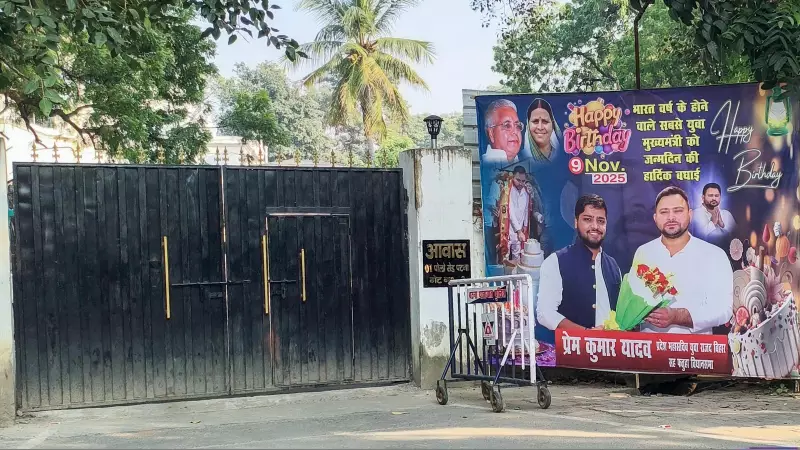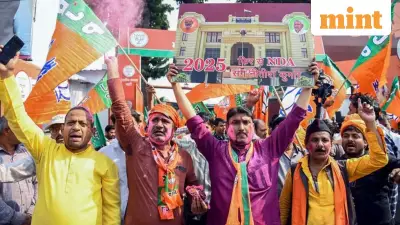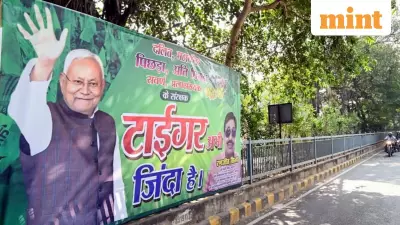
Bihar Election Verdict: NDA's Historic Sweep Leaves Opposition in Shambles
In a dramatic political reversal, the Opposition Mahagathbandhan faced a crushing defeat in the Bihar assembly elections, with the NDA securing a massive victory of 202 seats in the 243-member house. The coalition's two largest constituents, the Rashtriya Janata Dal (RJD) and Congress, witnessed a spectacular collapse that has sent shockwaves through Bihar's political landscape.
RJD's Spectacular Fall: From 75 to Just 25 Seats
The RJD, which emerged as the single-largest party in the 2020 elections with 75 seats, was projected to win only 25 seats this time - representing one of the most significant electoral declines in recent Bihar history. Meanwhile, the Congress party struggled to reach double digits, failing to capitalize on its alliance with the RJD.
This outcome marks a stunning reversal from five years ago when the Mahagathbandhan had fallen just 12 seats short of a simple majority. The November 15, 2025 results indicate a complete erosion of the opposition's support base across the state.
Why Tejashwi Yadav's Narrative Failed to Connect
Multiple factors contributed to the RJD's poor performance. Party leader Tejashwi Yadav had attempted to question Chief Minister Nitish Kumar's health, describing the NDA government as being in an "unconscious state" and labeling it "rickety." However, these attacks failed to resonate with voters.
Critically, the RJD leader who had shaken the NDA with his 10 lakh jobs promise in 2020 failed to offer any fresh vision this time. His promise of a government job for each family found few takers, while his Mai Bahin Maan Yojana offering Rs 2,500 to women beneficiaries was effectively countered by the NDA's more substantial Mukhyamantri Mahila Rojgar Yojana.
The NDA scheme, now famous as the "dashazari" program, provided eligible women entrepreneurs with Rs 10,000 as first installment and additional financial support of Rs 2 lakh within six months based on business performance. This helped Nitish Kumar consolidate his core constituency of women voters and completely overshadowed Tejashwi's narrative.
Coalition Mathematics Worked Against RJD
The RJD's previous successes relied heavily on favorable coalition dynamics. In 2015, the party rose from 22 seats in 2010 to 80 seats due to its formidable social combination with JD(U), with Congress acting as the glue. In 2020, the RJD became the single-largest party largely because Chirag Paswan's Lok Janshakti Party contested independently and damaged JD(U).
This time, the RJD had no such external factors working in its favor. The party attempted to stitch together a coalition to expand its base, but the Congress remained the alliance's weak link. Other allies including CPI (M-L) Liberation, Vikassheel Insaan Party (VIP), and Indian Inclusive Party (IIP) failed to add significant value to its social combination.
Lalu Prasad: Both Asset and Liability
Tejashwi's biggest asset - being the son of Lalu Prasad - also proved to be a liability. The years of Lalu's rule, remembered by many as "jungle raj," continued to haunt the RJD. While the party had overcome this narrative in 2015 and 2020 through strong social combinations and a weaker NDA alliance, these factors were absent in the 2025 elections.
Congress's Triple Failure in Bihar
Congress leaders identified three primary reasons for their party's dismal performance. First, the party's social justice pitch alienated its remaining upper-class and upper caste voters while failing to attract a sizable chunk of Extremely Backward Class (EBC) voters, who continued to support Nitish Kumar.
Second, the leadership's decision to focus exclusively on certain voter segments backfired. As one senior state Congress leader revealed: "Rahul Gandhi came to attend an EBC conference in my district. A little away, there was a village with sizeable Brahmin votes. A crowd of 5,000 was waiting, hoping Rahul would visit. But he did not. I was told the optics of his visiting a Brahmin village after attending an EBC conference would not be good. It can't be either or; we have to take everyone along."
Third, the party's "vote chori" narrative against the Special Intensive Revision of electoral rolls found no resonance with voters. Additionally, the decision to induct several turncoats from the NDA and allegations of irregularities in ticket distribution further damaged the party's credibility.
A Congress leader pointed out: "I can identify at least 10 candidates who had a past association with the NDA. Every party gives tickets to turncoats, but the Congress and Gandhi himself had been fighting the BJP and RSS tooth and nail. And if you give tickets to those whose social media walls still have photographs with NDA leaders, what credibility is left?"
Broader Implications for Bihar Politics
The election results indicate that the RJD's core Muslim-Yadav (M-Y) combination has become insufficient to secure electoral victory. As one Congress leader noted, "M-Y has now become mahila (women) and yuva (youth)," and the opposition failed to connect with these crucial demographics.
The NDA's focused approach on women and EBC voters, combined with the absence of a coherent opposition narrative and poor coordination between Rahul Gandhi and Tejashwi Yadav during campaigning, created a perfect storm that led to the Mahagathbandhan's comprehensive defeat.
As Bihar political landscape undergoes significant realignment, the 2025 election results may redefine opposition strategies and coalition politics in the state for years to come.





